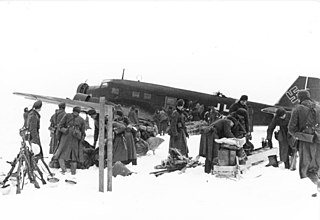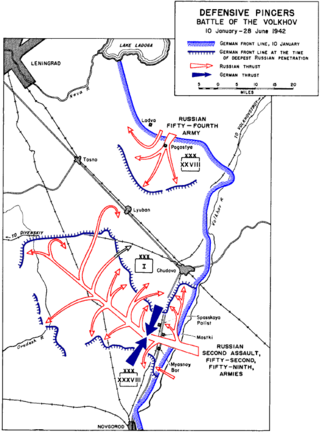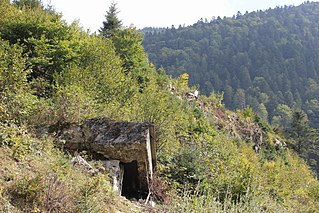An invasion is a military offensive in which large numbers of combatants of one geopolitical entity aggressively enter territory owned by another such entity, generally with the objective of either: conquering; liberating or re-establishing control or authority over a territory; forcing the partition of a country; altering the established government or gaining concessions from said government; or a combination thereof. An invasion can be the cause of a war, be a part of a larger strategy to end a war, or it can constitute an entire war in itself. Due to the large scale of the operations associated with invasions, they are usually strategic in planning and execution.

In warfare, infiltration tactics involve small independent light infantry forces advancing into enemy rear areas, bypassing enemy frontline strongpoints, possibly isolating them for attack by follow-up troops with heavier weapons. Soldiers take the initiative to identify enemy weak points and choose their own routes, targets, moments and methods of attack; this requires a high degree of skill and training, and can be supplemented by special equipment and weaponry to give them more local combat options.

A pocket is a group of combat forces that have been isolated by opposing forces from their logistical base and other friendly forces. In mobile warfare, such as blitzkrieg, salients were more likely to be cut off into pockets, which became the focus of battles of annihilation.

A counterattack is a tactic employed in response to an attack, with the term originating in "war games". The general objective is to negate or thwart the advantage gained by the enemy during attack, while the specific objectives typically seek to regain lost ground or destroy the attacking enemy.
Maneuver warfare, or manoeuvre warfare, is a military strategy which seeks to shatter the enemy's overall cohesion and will to fight.

Encirclement is a military term for the situation when a force or target is isolated and surrounded by enemy forces. The situation is highly dangerous for the encircled force. At the strategic level, it cannot receive supplies or reinforcements, and on the tactical level, the units in the force can be subject to an attack from several sides. Lastly, since the force cannot retreat, unless it is relieved or can break out, it must fight to the death or surrender.

The 8th Panzer Division was a formation of the WehrmachtHeer. The division was formed by reorganising the 3rd Light Division in October 1939. It was transferred to the west and fought in the Battle of France, in May 1940, and the German invasion of the Balkans in April 1941. Soon after the division advanced towards Leningrad under Army Group North in Operation Barbarossa, and would remain on the eastern front for the remainder of the war. Staying on defensive fronts, it saw action in the relief of Kholm in 1942, Orel and the withdrawals of Army Group Centre in 1943, until transferred to Army group South. The division then fought in a series of retrograde movements, back through Ukraine, into Hungary and finally into Silesia and surrender in May 1945.

The Demyansk Pocket was the name given to the pocket of German troops encircled by the Red Army around Demyansk, south of Leningrad, during World War II's Eastern Front. The pocket existed mainly from 8 February to 21 April 1942.
Deep operation, also known as Soviet Deep Battle, was a military theory developed by the Soviet Union for its armed forces during the 1920s and 1930s. It was a tenet that emphasized destroying, suppressing or disorganizing enemy forces not only at the line of contact but also throughout the depth of the battlefield.
A reverse slope defence is a military tactic where a defending force is positioned on the slope of an elevated terrain feature such as a hill, ridge, or mountain, on the side opposite from the attacking force. This tactic both hinders the attacker's ability to observe the defender's positions and reduces the effectiveness of the attacker's long-range weapons such as tanks and artillery.

The Battle of Königsberg, also known as the Königsberg offensive, was one of the last operations of the East Prussian offensive during World War II. In four days of urban warfare, Soviet forces of the 1st Baltic Front and the 3rd Belorussian Front captured the city of Königsberg, present day Kaliningrad, Russia. The siege started in late January 1945 when the Soviets initially surrounded the city. Heavy fighting took place for control of overland connection between Königsberg and the port of Pillau, however by March 1945 Königsberg was hundreds of kilometres behind the main front line in the eastern front. The battle ended when the German garrison surrendered to the Soviets on 9 April after a three-day assault made their position untenable.

The Battle of An Lộc was a major battle of the Vietnam War that lasted for 66 days and culminated in a tactical victory for South Vietnam. The struggle for An Lộc in 1972 was an important battle of the war, as South Vietnamese forces halted the North Vietnamese advance towards Saigon.
Envelopment is the military tactic of seizing objectives in the enemy's rear with the goal of destroying specific enemy forces and denying them the ability to withdraw. Rather than attacking an enemy head-on as in a frontal assault an envelopment seeks to exploit the enemy's flanks, attacking them from multiple directions and avoiding where their defenses are strongest. A successful envelopment lessens the number of casualties suffered by the attacker while inducing a psychological shock on the defender and improving the chances to destroy them. An envelopment will consist of one or more enveloping forces, which attacks the enemy's flank(s), and a fixing force, which attacks the enemy's front and "fixes" them in place so that they cannot withdraw or shift their focus on the enveloping forces. While a successful tactic, there are risks involved with performing an envelopment. The enveloping force can become overextended and cut off from friendly forces by an enemy counterattack, or the enemy can counterattack against the fixing force.

The Battle of Lyuban, Lyuban offensive operation or Battle of the Volkhov was a Soviet offensive operation of World War II. It was conducted by the Volkhov and Leningrad Fronts of the Red Army with the goal of relieving the siege of Leningrad and encircling and destroying the German forces carrying out the siege.
Defence in depth is a military strategy that seeks to delay rather than prevent the advance of an attacker, buying time and causing additional casualties by yielding space. Rather than defeating an attacker with a single, strong defensive line, defence in depth relies on the tendency of an attack to lose momentum over time or as it covers a larger area. A defender can thus yield lightly defended territory in an effort to stress an attacker's logistics or spread out a numerically superior attacking force. Once an attacker has lost momentum or is forced to spread out to pacify a large area, defensive counter-attacks can be mounted on the attacker's weak points, with the goal being to cause attrition or drive the attacker back to its original starting position.

The Árpád Line was a line of fortifications built in 1941-44 in the north-eastern and eastern Carpathian Mountains, along the border of Kingdom of Hungary. It was named after Árpád, the head of the Hungarian tribes. The main function of the Line was to protect Northern Transylvania and Carpathian Ruthenia from the east.

The flexible defense is a military theory about the design of modern fortifications. The examples of "flexible" defense-lines are not based on dense lines of heavily armed, large and expensive concrete fortifications as the systems such as the Maginot Line were. Their protective capacity hinges on multiple lines of obstacles and small shelters fitting into the environment. They are "flexible" because soldiers are not locked in pillboxes, but fight instead in easily replaceable open earth-wood made positions, while bunkers serve only as shelters during bombardments. As a result, they are able to adapt to the opponent's movements, and there are no easily targeted large buildings in these lines.
The 23rd Guards Rifle Division was reformed as an elite infantry division of the Red Army in March, 1942, based on the 1st formation of the 88th Rifle Division, and served in that role until after the end of the Great Patriotic War. It was one of just two Guards divisions to be formed in the far north, the 10th Guards being the other. It continued to serve in Karelian Front, where it was formed, until October when it was railed south to join the 1st Shock Army of Northwestern Front; it would remain in that Army until nearly the end of 1944. Over the next several months it took part in the dismal fighting around the Demyansk salient until it was evacuated by the German II Army Corps in March, 1943. During the rest of the year the division continued battling through the forests and swamps south of Lake Ilmen, occasionally under command of the 14th Guards Rifle Corps, until the Leningrad-Novgorod Offensive began in late January, 1944. The 23rd Guards took part in the liberation of Staraya Russa in mid-February and went on to win a battle honor about a week later at Dno. 1st Shock Army closed up to the German Panther Line south of Lake Peipus during the spring and then helped break through it at the start of the Baltic Campaign in July. For its part in the liberation of Ostrov the division was awarded the Order of the Red Banner before gradually advancing through Latvia towards Riga, which it helped to liberate in October. By now it was in the 12th Guards Rifle Corps which was transferred in late November to the 3rd Shock Army in 1st Belorussian Front. The 23rd Guards would remain under these commands for the duration of the war, advancing across Poland and eastern Germany into Berlin in 1945 and winning a second honorific after the fighting ended. Despite a fine record of service it was disbanded in 1947.
The 241st Rifle Division was formed as an infantry division of the Red Army from the remnants of the 28th Tank Division in November/December 1941. It was based on the shtat of July 29, 1941 and was reformed in the 27th Army of Northwestern Front. It was soon moved to 34th Army and later to 53rd Army in the same Front, playing a relatively minor role in the battles against German 16th Army's forces in the Demyansk salient into the first months of 1943. Following the evacuation of the salient the division was moved southward to the Steppe Military District, joining the 2nd formation of the 27th Army. It next saw action in Voronezh Front's counteroffensive following the German offensive at Kursk, becoming involved in the complex fighting around Okhtyrka and then advancing through eastern Ukraine toward the Dniepr River. The 241st took part in the unsuccessful battles to break out of the bridgehead at Bukryn and after the liberation of Kyiv it was reassigned to 38th Army, remaining under that command, assigned to various rifle corps, mostly the 67th, for the duration of the war. In the spring of 1944 it won a battle honor in western Ukraine, and during the summer several of its subunits received recognition in the battles for Lviv and Sambir. During the autumn it entered the Carpathian Mountains and took part in the fighting for the Dukla Pass before being transferred, along with the rest of 38th Army, to the 4th Ukrainian Front. This Front advanced through Slovakia and southern Poland in the first months of 1945 and the division's subunits won further distinctions, but the division itself only received one, fairly minor, decoration. It ended the war near Prague and was disbanded during the summer.











